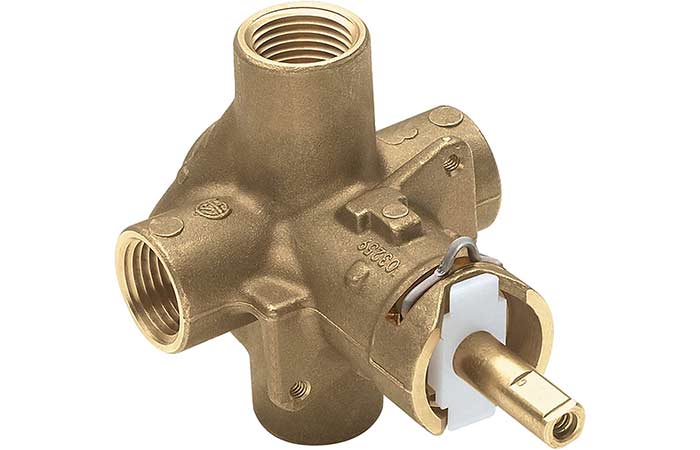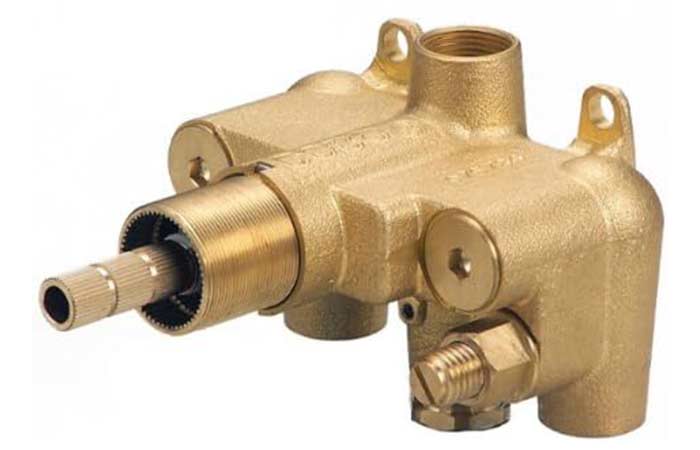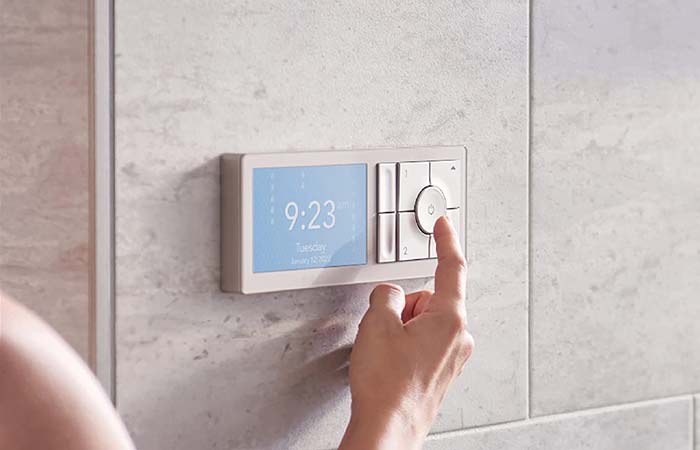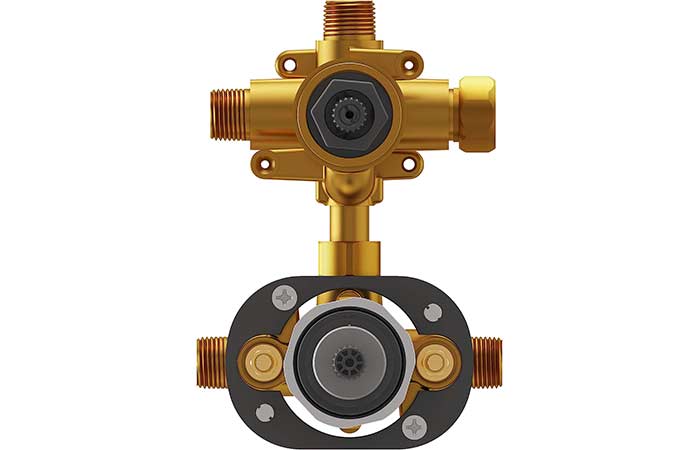Types of Shower Diverters
Choosing the right shower diverter allows you to redirect the water flow and adjust the water temperature, saving water and energy.
Types of shower diverters include pressure-balanced, thermostatic, single valve, digital/smart, manual, three-way- valve, two-way valve, push button, integrated, stacked, and shower arm.
Continue reading below for more information, including the advantages and disadvantages of each type.
Pressure-balanced Shower Diverter
This type of shower diverter works by sensing changes in water pressure and adjusting the water flow to maintain a balance between the hot and cold water supplies. This prevents changes in water pressure from affecting the temperature of the water coming out of the shower head.

For example, if someone turns on the faucet in another part of the house, it will automatically adjust the flow of water to the shower to compensate for the change in pressure. This also helps prevent sudden changes in water temperature or pressure that can be uncomfortable or dangerous.
You can install it in several ways; you can install it into the shower valve itself or add it as a separate component to an existing shower valve.
Advantages
- Improves safety by preventing scalding and sudden changes in water temperature.
- Enhances comfort by providing consistent water pressure and temperature
- Increases durability by preventing sudden changes in water pressure, which can help to prolong the life of the shower and its components.
- Easy to use.
- It helps to conserve water by maintaining a consistent flow of water.
Disadvantages
- It can be sensitive to changes in water pressure, which can cause fluctuations in the temperature of the water.
- If you use one shower outlet while turning another off, it may not be able to maintain the desired temperature.
- It’s expensive
Thermostatic Shower Diverter
It controls water flow between multiple shower components, such as a shower head and a handheld shower wand. It typically includes a thermostatic valve that maintains a consistent water temperature, even if someone else uses the water in the house.

It automatically shuts off the water flow if the temperature becomes too hot. Inside the diverter, there is a thermostatic cartridge that contains a thermistor, which is a device that measures the temperature of the water. The thermostatic cartridge also includes a mixing valve, which enables you to adjust the hot and cold water flow to achieve the desired temperature.
It has a lever or knob that you can turn to redirect the water flow between the different shower components. This allows you to switch between a shower head and a handheld wand without adjusting the water temperature each time.
Advantages
- Controls water temperature
- It provides safety by preventing scalding, as it will automatically shut off the water flow if the temperature becomes too hot.
- You can easily switch between different shower heads without needing to adjust the temperature again.
- It helps conserve water and energy by maintaining a consistent water temperature.
- It’s durable.
Disadvantages
- It is expensive
- It may be more complex to install and maintain
- Some may only allow you to switch between two different shower heads, while others may have more limited control options.
- It has more complex internal mechanisms than traditional diverters, which can increase the risk of leaks.
- If it malfunctions, it may not maintain a consistent water temperature.
- It requires power to operate, making it impossible to use in power outages.
Single Valve Diverter or T Diverter
It typically has one handle or lever that controls water flow to the various outlets. When you pull it up, it redirects water flow from the faucet to the shower head. To switch back to the faucet water flow, push the diverter back to its original position.
It consists of a valve stem, handle, and cartridge. The valve stem connects to the handle, which controls the water flow. The cartridge is the internal mechanism that controls the flow of water and diverts it to the outlet.
When installing it, it is essential to ensure that it is compatible with the existing plumbing and that the valve stem is of the correct length.
This shower diverter can be used without special tools or installation knowledge. All you need to do is remove the existing bug sprayer or shower head and replace it with a new single-valve diverter.
Advantages
- It is easy to operate,
- It takes up less space than multi-valve diverters
- It is Cost-effective
- Easy to repair and maintain
- Conserve water
Disadvantages
- You can only control one shower head at a time, which may not be ideal if you have multiple shower heads or want to use various shower heads simultaneously.
- Difficulty in adjusting water flow and temperature because it may provide less precision adjusting water flow and temperature than a multi-valve diverter would.
- It is less durable
- It may not be compatible with all types of shower systems, which can make installation and replacement more difficult and costly
A Three-valve Diverter
It is a device that allows different flow rates of hot and cold water through your shower head through three outlets. The name comes from the fact that there are three valves on the diverter.
It works by providing two different water flows while maintaining one constant temperature. This can help keep your water temperature consistent, especially if you’re using a slight stand-alone mixer tap as your primary source of hot water.
When you turn on the shower, the water flows from the water pipes up to the diverter. You can use this diverter to control the water flow by sending it to one of three outlets. You can use each for another purpose, such as controlling the temperature of the water or the amount of water coming out of the shower.
The first outlet is the main showerhead. This is the primary outlet. It connects to the main water pipe, and you can adjust it to change the temperature or pressure of the water coming out.
The second outlet is the handheld showerhead. This is usually a smaller outlet and is great for a quick rinse in the morning or a spot cleaning throughout the day.
The third outlet is the body sprayer. It can give you a more even water flow that can help massage or soothe sore or aching muscles.
Advantages
- It allows for more precise control over water flow between multiple showering devices, such as a shower head and a handheld shower wand.
- Conserve water.
- It typically has a more durable and long-lasting design than a single-valve diverter.
Disadvantages
- It can be more complicated to install and repair than a single-valve diverter.
- It may require more maintenance and cleaning to keep it functioning correctly.
- Compared to a single-valve diverter, it is expensive.
Two-valve Diverter
This shower diverter allows the user to switch between different shower heads in a bathroom. It has two valves, one for controlling the flow of water to the primary shower head and another for controlling the flow to a secondary shower head.
When you turn the handle to the left, it directs the water flow to the primary shower head, and when you turn it right, it directs the water flow to the secondary shower head.
You can use this type of diverter on both small and large bathrooms, as well as in different kinds of showers. Its design allows you to control how much water you want to use while still allowing you to enjoy your shower experience without worrying about wasting any water or having cold water come out of your shower head.
You can mount it on the wall near the shower and operate it with a handle or lever. This handle or lever switches between the two valves, allowing the user to choose the desired water flow.
Advantages
- Easy to use
- Compared to a three-valve diverter, it is less expensive.
- It takes up less space than a three-valve diverter.
- It is durable, durable
- Conserve water
- Easy to maintain
Disadvantages
- It has limited control because it only allows the user to switch between the shower head and the tub spout and does not offer individual control over the water flow to each.
- Diverting water to multiple outlets can reduce the overall water pressure.
- It may be more prone to leakage due to the additional valve and connection points.
- It may be more difficult to repair due to the complexity of the valve mechanism.
- It may be less aesthetically pleasing than more modern designs and may not match the bathroom’s overall strategy.
Digital/Smart Diverter
These types of shower diverters allow you to control multiple water outlets, water temperature, and other shower functions with precision and programmable settings via digital controls including touchscreens or buttons, remote controllers, voice, or mobile apps.

Pros
- Digital shower diverters provide convenient control over your shower experience compared to traditional diverters
- Allow you to personalize your shower experience through a wide range of water flow and temperature settings
- Help to conserve water and reduce energy consumption through features like flow rate monitoring, temperature controls and real-time usage data.
- Many digital shower diverters are designed to integrate with smart home ecosystems to create a seamless, connected experience.
- Some digital shower diverters include safety features such as temperature limits or anti-scald protection, ensuring that the water temperature remains within safe limits to prevent accidental burns.
Cons
- Digital shower diverters tend to be more expensive compared to traditional manual diverters.
- May not be compatible with existing plumbing infrastructure
- Heavily rely on technology, you are likely to lose control over your shower experience if the system malfunctions
- Options available are limited compared to traditional shower diverters.
- Installation may require professional assistance, especially if it involves retrofitting an existing shower setup
- Some users may find it initially challenging to navigate the digital controls and understand the full range of features and settings available
Manual Shower Diverter
It has a lever or knob that allows you to manually adjust water temperature and pressure. It is a popular choice for those looking to upgrade their shower system or for those building a new home.
It offers a convenient and easy way to switch between different showering options, allowing for a more customizable and enjoyable showering experience. It is relatively simple in design and is generally very durable.
In terms of materials, some designs may consist of metal and plastic, which are easy to install. Some models may require a professional plumber for the installation, but many you can install them with basic plumbing knowledge.
It can save water by allowing users to turn off one shower head or valve while using another. This can also help conserve energy by reducing the hot water used.
Advantages
- Conserve water
- Easy to use
- It is reliable
- Compared to Thermostatic, it’s less expensive.
Disadvantages
- Difficulty in adjusting the water flow: If the diverter is difficult to turn or move, it may be challenging for some individuals, such as those with limited dexterity, to adjust the water flow between the shower head and other fixtures, such as a handheld shower or tub spout.
- It may provide less control over the water flow than a thermostatic, making achieving the desired temperature or flow rate more challenging.
- It may wear and tear quickly.
It has a lever on each side of the handle that you can pull down and back to open or close the diverter. It is easy to operate because it has only two parts: the handle, which you push down and back, and a lever inside that engages with it.
This is a very safe type of diverter because it cannot hurt a person if they accidentally pull it or open too far. It is also called a “push-pull” style because you simultaneously push down on one side and pull up on the other.
There are two types of push-button shower diverters: standard and single-lever. The single-lever version has a single lever on the head side that controls all the functions, while the standard version has two levers for each setting.
Both versions have a detachable hose with 3/8-inch threads, which makes them compatible with any standard hose connection with or without a valve.
It comes in different styles and is available in other materials such as plastic, rubber, and metal. The push button design also makes it convenient for older adults who may not be able to reach far when turning off their water at home due to arthritis or other medical conditions affecting their hands or wrists.
Advantages
- It is easy to use.
- It is durable
- Conserve water
- It can be sleek and modern in design, adding style to your bathroom.
Disadvantages
- It only allows you to switch between two different showering options, such as the showerhead and a handheld shower. This can be limiting if you want more control over the water flow or switch between multiple showering options.
- It can be challenging to use for people with limited hand strength or dexterity. The buttons can be hard to press or locate, making it challenging for some individuals to use the shower.
- It can develop leaks over time, making it difficult and costly to repair.
Integrated Diverter
It allows easy switching between different showering components without additional valves or plumbing. This saves time and money during the installation process and makes it easier to use and maintain the shower.
It comes with a unique spring-loaded gate, making it easy to open and close the diverter when adjusting the water flow. It also has a flexible hose that adjusts the water flow without disassembling the entire shower head assembly.
It comes in various styles and designs to match the aesthetic of the shower. It can be modern and sleek or more traditional and ornate. Some even come in multiple finishes, such as chrome, brushed nickel, or oil-rubbed bronze, to match the hardware in the bathroom.
When choosing it, you must consider the type and number of showering components you will use. Some diverters work with a single shower head or hand shower, while others work with multiple features.
Advantages
- Save space
- It is convenient to use
- Improves water flow
- Aesthetics
- It is durable
Disadvantages
- It may be more challenging to repair or replace if they become damaged or malfunction.
- It may only be compatible with some shower heads or valves, making switching difficult.
- It is more expensive compared to a single valve and manual.
Stacked Diverter
It consists of brass materials and has two ports: one for hot water and one for cold. The diverter has an adjustment knob, which you can turn to change how much hot or cold water comes out of the shower head.
Its shape can vary depending on the specific application and the water flow it can control. However, it is generally cylindrical, with the diverters located at the top of the valve.

Some diverters also have a push-pull mechanism, where the user can push down on the knob to activate the handheld showerhead and pull up on the knob to start the fixed showerhead.
Advantages
- Save space
- Easy to use
- It’s durable
- Conserve water
Disadvantages
- It can be challenging to repair if it becomes damaged or malfunctioning.
- It may only be compatible with some shower heads or valves, limiting design options.
- The diverter can lead to leakage or water pressure issues if not correctly installed.
Shower Arm Diverter
It is a device that connects to a standard shower arm and allows you to easily switch between a handheld showerhead and a fixed wall-mounted showerhead. This shower diverter allows you to switch between different shower heads easily.
For example, you can change from a rain shower head to a handheld one and back again. This can be useful if you have mobility issues or want to wash your pets or children in the shower.
It comes in a variety of shapes, sizes, and styles.
Some designs allow them to fit inside the shower arm, and you can operate them manually. In Other methods, you can mount them on the wall and use a valve that you can adjust to split the water flow.
It is a convenient way to control water flow to different outlets. This can be useful when multiple people are sharing a shower or when someone needs to take a shower at a different temperature than what is available from the main shower head.
In addition to controlling the flow of water, it also allows for precise control over the water temperature.
Advantages
- It increases versatility because it allows you to switch between different shower head options.
- Saves spaces
- Conserve water
- Easy to use
Disadvantages
- It can restrict the flow of water, making the shower less powerful.
- It can leak if you don’t install and maintain it properly.
- It can be complex to install and may require a professional plumber.
- It is expensive
- Not all shower heads are compatible with this type, and you may need to purchase a specific style that works with the diverter.
- Some people may not like the look of a diverter and prefer a more traditional shower head.
References
- https://www.ricksplumbing.com/blog/what-you-should-know-about-shower-diverters/
- https://www.mrrooter.com/about/blog/2018/august/how-does-a-shower-diverter-work-/
- https://www.signaturehardware.com/media/pdf/three-way-in-wall-diverter-additional-information.pdf
- https://www.fimacf.in/what-are-the-benefits-of-installing-a-thermostatic-diverter/
- https://youtu.be/OGOdIcKWi6I